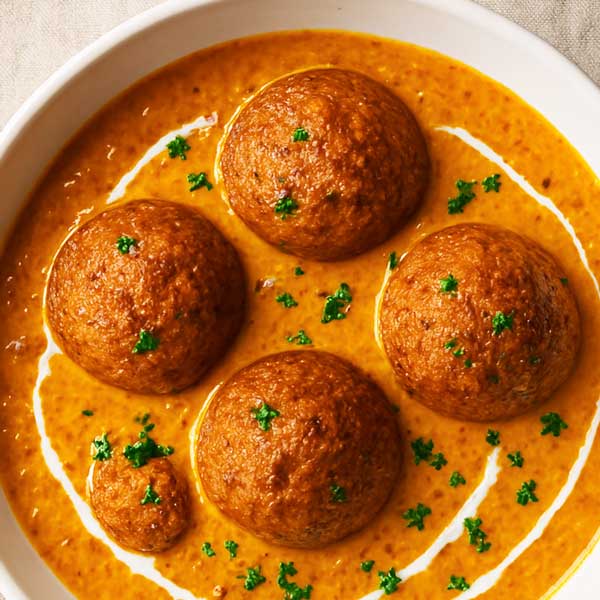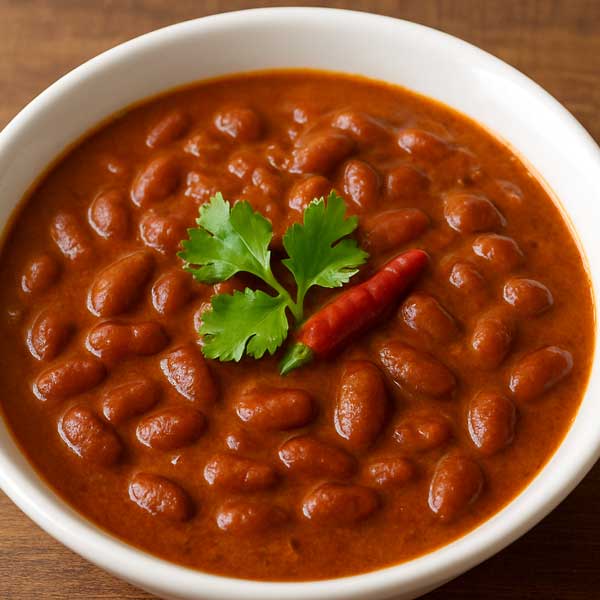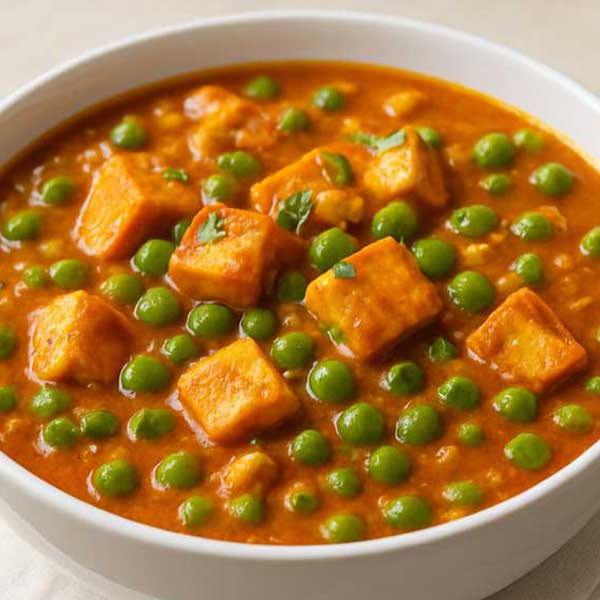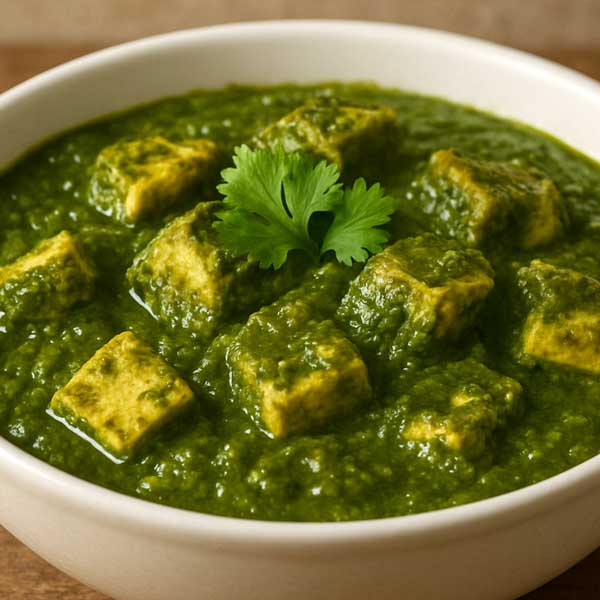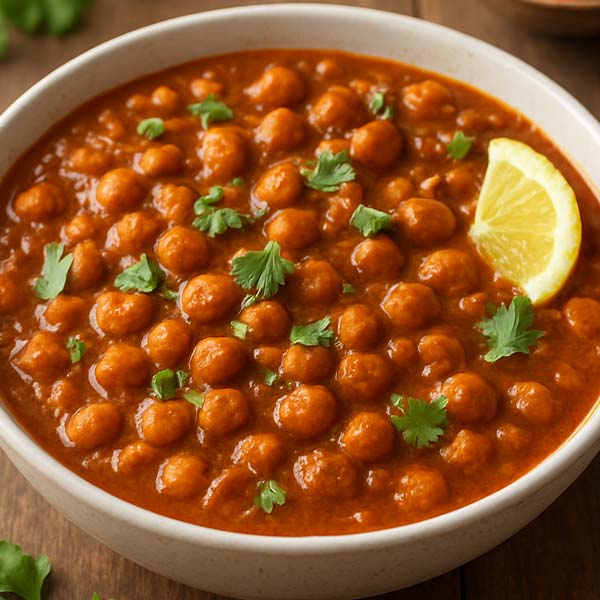Saag Paneer Recipe
If there’s one dish that takes me straight back to the comfort of a home-cooked Indian meal, it’s Saag Paneer, also known as Indian spinach paneer curry. This creamy, spiced Indian vegetarian dish is the kind of food that warms you from the inside out. Soft cubes of golden-fried paneer cheese soak up a luscious green gravy made with fresh spinach, garlic, ginger, onions, tomatoes, and aromatic Indian spices like cumin and garam masala. Whether you’re pairing it with fluffy basmati rice, soft roti, or tearing into a warm garlic naan, this North Indian curry recipe is pure comfort in a bowl and the best part is, it’s surprisingly easy to make at home.
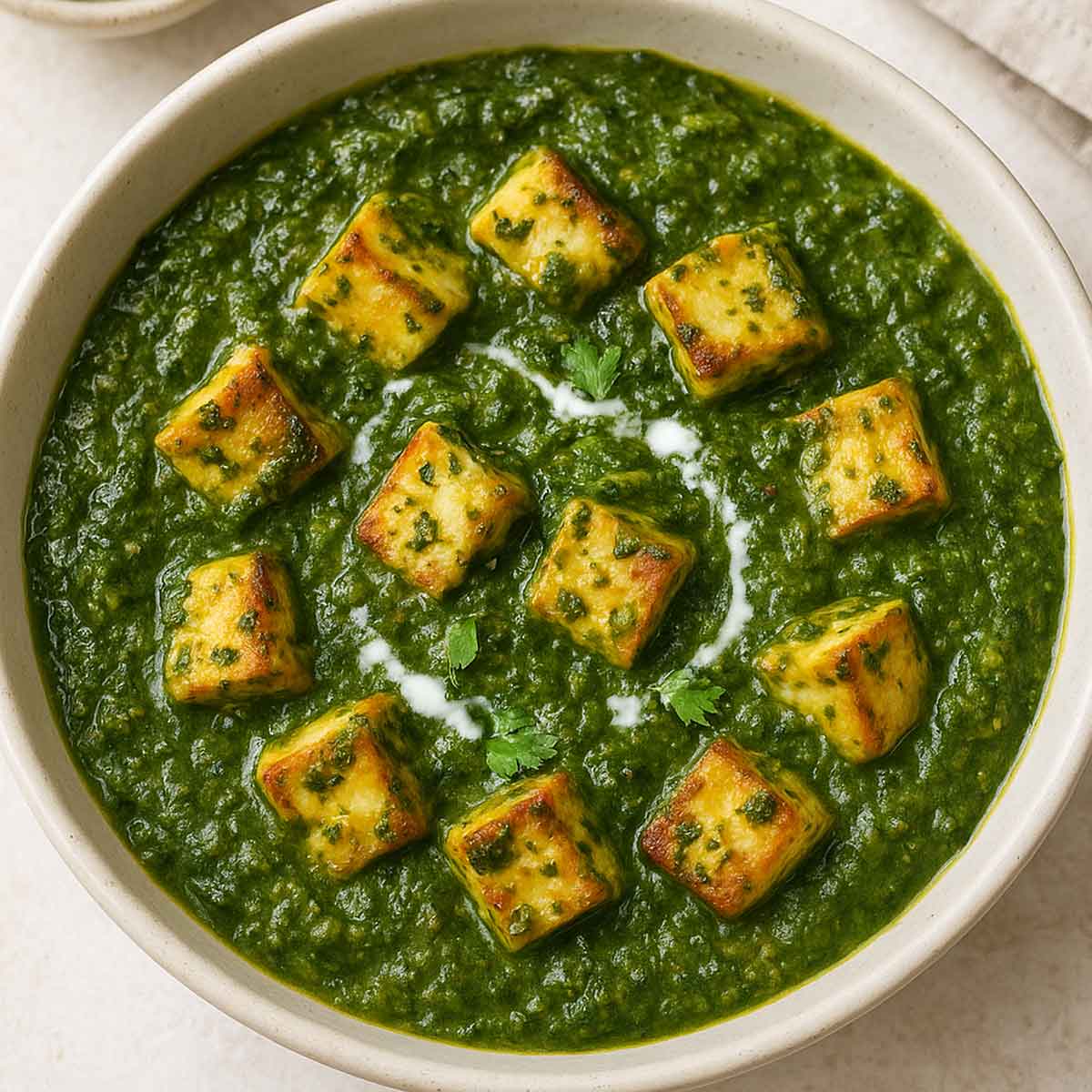
Paneer is a fresh, non-melting cheese popular in Indian cuisine. Made by curdling milk with lemon juice or vinegar, it has a soft yet firm texture and a mild flavor that absorbs spices beautifully. It’s packed with protein, making it a favorite in vegetarian Indian recipes like Palak Paneer, Paneer Butter Masala, and of course, Saag Paneer. Unlike cheese in Western dishes, paneer is not aged and has no salt added, which makes it versatile for both savory and sweet Indian recipes.
What is Saag Paneer?
In Hindi and Punjabi, “saag” means leafy greens – often spinach, mustard greens, or a mix of seasonal greens. Saag Paneer is a North Indian vegetarian curry where these greens are cooked down with onions, tomatoes, ginger, garlic, and aromatic spices, then blended into a smooth, creamy gravy. Soft paneer cubes are simmered in this gravy, soaking up all the flavors. It’s traditionally served with roti, naan, paratha, or steamed basmati rice, and is especially popular in Punjabi households.
Some call it Palak Paneer when it’s made only with spinach, but Saag Paneer can be richer in flavor with a mix of greens giving you a taste of India’s rustic countryside cooking right in your kitchen.
Ingredients & Substitutes
- Paneer: I used fresh, soft paneer, it soaks up the creamy spinach gravy beautifully. You can use: Firm tofu for a vegan saag tofu version, or even halloumi if that’s easier to find where you live.
- Fresh spinach: Baby spinach works perfectly here, but any spinach will do. You can use: Frozen spinach (thaw and squeeze out extra water), or mix in mustard greens or kale for a more rustic, slightly bitter flavor like a Punjabi-style saag.
- Onions: They add a lovely sweetness to balance the spices. You can use: One large onion or 6–7 shallots if you want a gentler, more delicate flavor.
- Tomatoes: These give the curry its tang and body. You can use: Canned diced tomatoes or tomato puree handy when fresh tomatoes aren’t in season.
- Green chilies: This is where the heat comes from, so add more or less to your taste. You can use: Jalapeño slices for a milder kick, or red pepper flakes if that’s what’s in your pantry.
- Ginger-garlic paste: The warm, earthy aroma makes the whole kitchen smell amazing. You can use: Equal parts minced fresh ginger and garlic if you don’t have the paste.
- Oil or ghee: Ghee gives a rich, nutty flavor, but oil works just fine. You can use: Butter, coconut oil, or any neutral vegetable oil.
- Cumin seeds: They add a lovely earthy fragrance at the start of cooking.
- You can use: Ground cumin (about a quarter teaspoon) if seeds aren’t handy — add it with the other powdered spices instead.
- Coriander powder: Adds warmth and depth to the curry. You can use: A cumin-coriander spice blend, or even a mild curry powder in a pinch.
- Turmeric powder: Just a touch for color and subtle earthiness. You can use: Skip if you must, but it does give that gorgeous golden hue.
- Red chili powder: For spice and a pop of color. You can use: Paprika for a mild version, or cayenne pepper if you like it fiery.
- Garam masala: This is the final sprinkle that ties everything together. You can use: Curry powder, or a little mix of cinnamon, cardamom, and cloves.
- Salt: Brings out all the flavors. You can use: Sea salt, Himalayan pink, or kosher salt.
- Fresh cream (optional): I love swirling this in before serving for a restaurant-style finish. You can use: Coconut cream for a vegan twist, or just skip it if you’re keeping things light.
How to make Saag Paneer (Recipe steps)
1. Blanch 4 cups of fresh spinach (palak) in boiling water for 2 minutes, transfer immediately to ice-cold water to retain the vibrant green color, and blend with 2 green chilies into a smooth spinach puree for the saag curry base.
2. Heat 2 tablespoons ghee or oil in a non-stick pan, fry 250 grams paneer cubes until golden and slightly crispy, then remove and set aside for the creamy paneer curry.
3. In the same pan, add 1 teaspoon cumin seeds, 2 finely chopped medium onions, and 1 tablespoon ginger-garlic paste, sautéing until golden brown for that authentic Indian curry flavor.
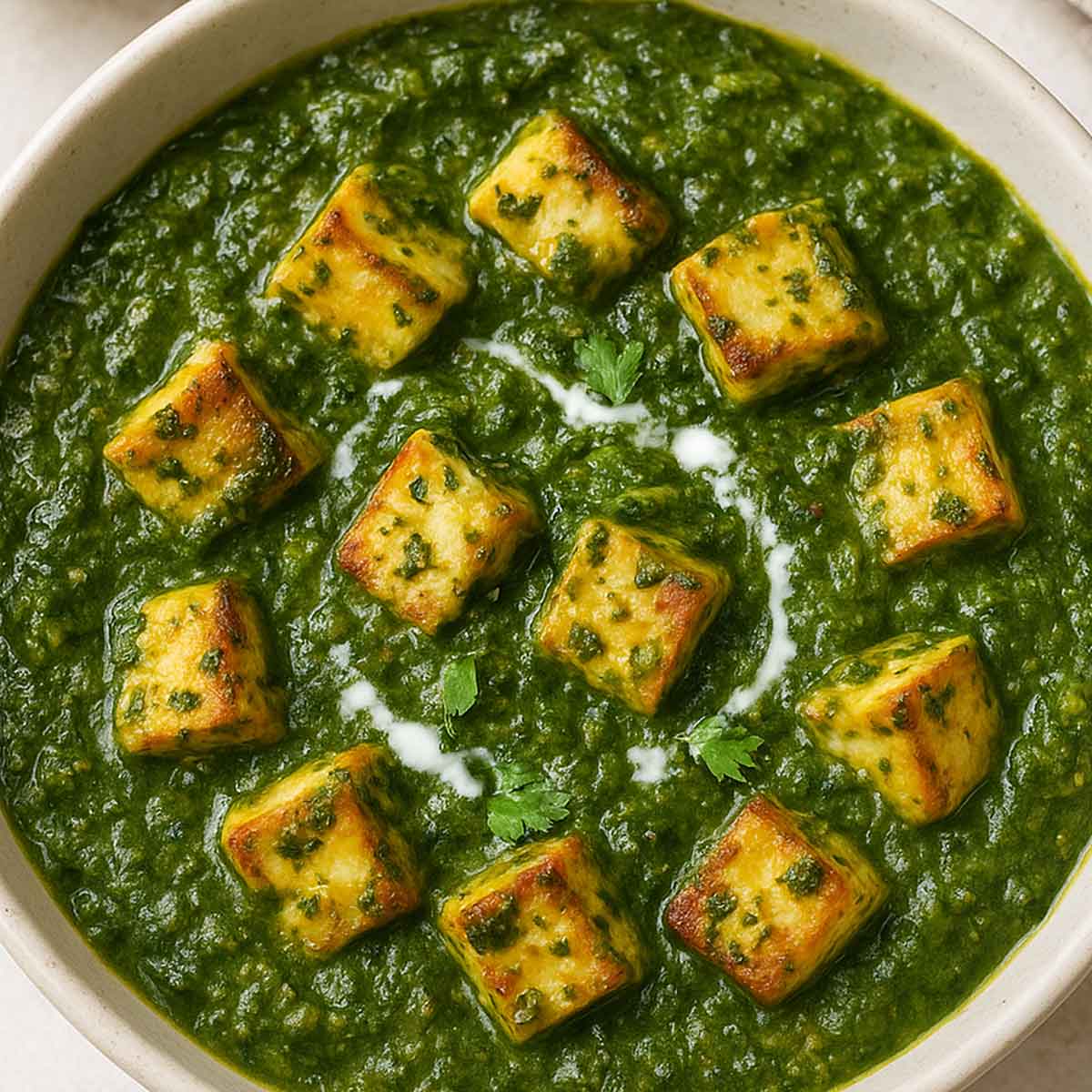
4. Mix in 2 chopped medium tomatoes along with ½ teaspoon turmeric, 1 teaspoon coriander powder, ½ teaspoon red chili powder, and 1 teaspoon salt, cooking until the masala releases oil the spice blend that defines North Indian vegetarian recipes.
5. Stir in the spinach puree, simmer gently for 5–6 minutes, then add the fried paneer cubes with ½ teaspoon garam masala, finishing with 2 tablespoons fresh cream or coconut cream for a restaurant-style saag paneer; serve hot with naan, roti, or steamed basmati rice for a healthy vegetarian Indian dinner.
Frequently asked questions
Saag Paneer and Palak Paneer are both popular North Indian paneer dishes, but they are not exactly the same. Saag Paneer is made with a mix of leafy greens such as mustard leaves (sarson), spinach (palak), fenugreek leaves (methi), and sometimes bathua or kale. This gives it a more earthy, slightly bitter, and rustic flavor. On the other hand, Palak Paneer uses only spinach leaves, resulting in a smoother, milder, and sweeter taste. While both are creamy paneer curries, Saag Paneer is more traditional in Punjabi and rural cooking, especially during winter.
Absolutely! Saag Paneer is packed with nutrition thanks to the leafy greens, which are rich in iron, calcium, fiber, and antioxidants. Paneer provides high-quality protein and healthy fats, making it a wholesome vegetarian meal. Using less ghee or oil and pairing it with whole wheat roti or brown rice can make it even healthier. Since this dish combines protein with leafy greens, it’s considered a balanced meal in Indian vegetarian cooking, especially in Punjabi winter diets.
The secret is in slow cooking. Letting the greens simmer for a longer time deepens the flavor and creates a creamy consistency without adding too much cream. A hand blender can be used to slightly puree the cooked greens before adding paneer, resulting in that silky texture you often find in restaurants.
Saag Paneer tastes best with makki ki roti (cornmeal flatbread), which is a classic Punjabi winter pairing. You can also serve it with hot phulkas, naan, paratha, or steamed basmati rice. For a complete meal, pair it with a side of pickled onions, fresh green chilies, and a glass of lassi or chaas. If you’re going for a healthier version, brown rice or multigrain roti works well too. This dish is hearty, comforting, and perfect for both everyday meals and festive Indian dinners.
Absolutely. Instead of dairy paneer, tofu works wonderfully in the recipe. It absorbs the spices well and keeps the protein content high. Ghee can be swapped with neutral oil or vegan butter to make the dish fully plant-based, while still maintaining its rich texture.
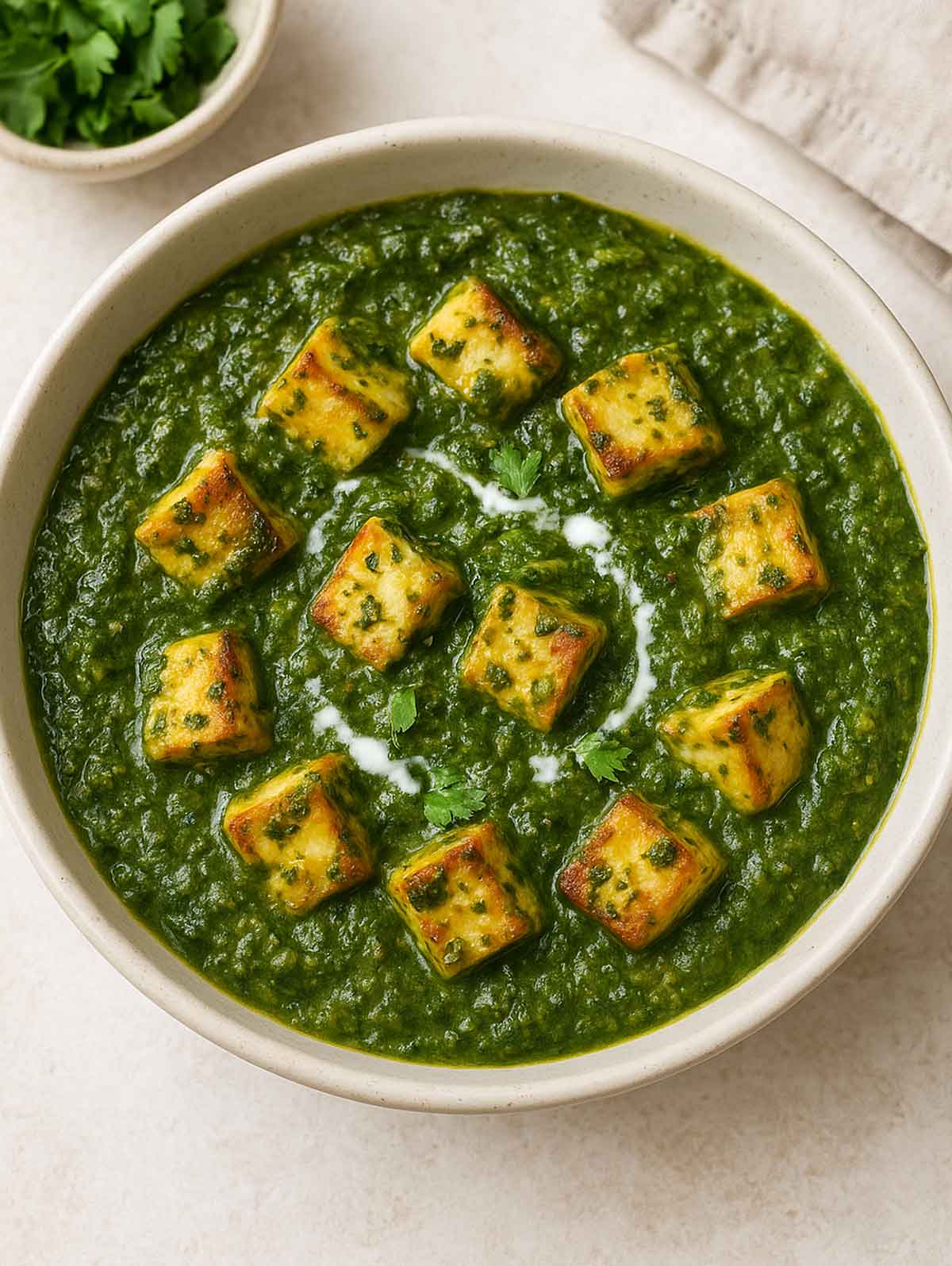

Saag Paneer
Equipment
- 1 Large saucepan
- 1 Blender
- 1 Wooden spoon
- 1 Chopping board
- 1 Knife
Ingredients
- 4 cups fresh spinach – washed and chopped
- 1 cup mustard greens – optional but adds authentic Punjabi flavor
- 2 green chilies – adjust to taste
- 1 large onion – chopped
- 2 medium tomatoes – chopped
- 1- inch ginger – grated
- 4 cloves garlic – minced
- 2 tbsp ghee clarified butter – for authentic flavor
- 1 tbsp oil – for cooking
- 1 tsp cumin seeds jeera
- 1 tsp coriander powder
- ½ tsp turmeric powder
- ½ tsp red chili powder
- ½ tsp garam masala
- Salt – to taste
- ½ cup water or as needed
- 250 g paneer Indian cottage cheese – cubed
- 1 tsp oil or ghee – for lightly frying paneer cubes
Instructions
- Bring about 4 cups of water to a boil in a large pot. Add fresh spinach leaves and cook for just 2 minutes until they wilt. This helps keep that beautiful green color. Drain immediately and plunge into ice-cold water — a trick that makes your Indian spinach curry vibrant instead of dull.
- Pop the blanched spinach and a couple of green chilies into a blender. Blend until smooth. This puree is the heart of a good creamy saag recipe.
- Heat 1 tablespoon of oil or ghee in a non-stick pan. Add the paneer cubes and fry until golden on all sides. This step gives them a delicious, slightly crispy edge that stands out in a creamy paneer dish. Remove and set aside.
- In the same pan, add the rest of the oil or ghee. Toss in cumin seeds and let them sizzle for a few seconds. Add chopped onions and sauté until golden brown — this is where the aroma of a traditional Indian curry starts filling your kitchen. Stir in ginger-garlic paste and cook for a minute.
- Add chopped tomatoes and cook until soft and the oil begins to separate. Then mix in turmeric, coriander powder, red chili powder, and salt. This spice blend is the backbone of many North Indian vegetarian recipes.
- Pour in your green spinach puree and stir well. Let it simmer gently for 5–6 minutes so the flavors blend into a rich, earthy saag gravy.
- Add the fried paneer cubes back in along with garam masala. Stir gently so the paneer stays intact. Simmer for another 3–4 minutes for the flavors to marry into a perfect paneer curry.
- Drizzle fresh cream on top for a restaurant-style Indian dish, or use coconut cream for a vegan touch. Serve hot with naan bread, roti, or steamed basmati rice for a complete healthy vegetarian Indian dinner.

